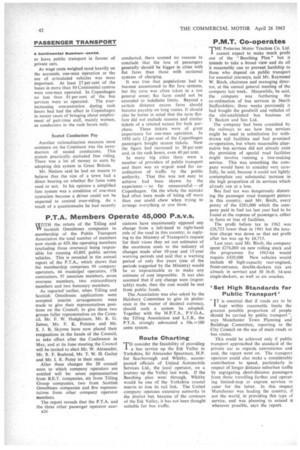P.M.T. Co-operates
Page 44

If you've noticed an error in this article please click here to report it so we can fix it.
THE Potteries Motor Traction Co. Ltd. cannot expect to make much profit out of the " Beeching Plan" but it intends to take a broad view and do all it reasonably can to prevent hardship to those who depend on public transport for essential journeys, said Mr. Raymond W. Birch, chairman and managing director, at the annual general meeting of the company last week. Meanwhile, he said, the company was furthering the co-ordination of bus services in North Staffordshire; three weeks previously it had bought the goodwill and vehicles of the old-established bus business of T. Beckett and Son Ltd.
The company had been consulted by the railways to see how bus services might be used in substitution for withdrawn rail facilities and had promised co-operation, but where reasonable alternative bus services did not already exist the provision of special road facilities might involve running a loss-making service. This was something the company would have to consider very carefully, he said, because it could not lightly contemplate any substantial increase in the high proportion of its services which already ran at a loss.
Bus fuel tax was dangerously distorting the passenger road transport picture in this country, said Mr. Birch.; every penny of the £261,000 which the company paid in fuel tax last year had to be found at the expense of passengers, either in fares or loss of facilities.
The profit before tax in 1962 was £26,753 lower than in 1961 but the taxation charge was down so that net profit after tax was up by £8,715.
Last year, said Mr. Birch, the company spent £276,000 on new rolling stock and the programme for 1963-64 would require £420,000 New vehicles would include 40 high-capacity rear-engined, front-entrance, double-deckers (six are already in service) and 30 36-ft. 54-seat single-deckers, as well as six coaches.












































































































